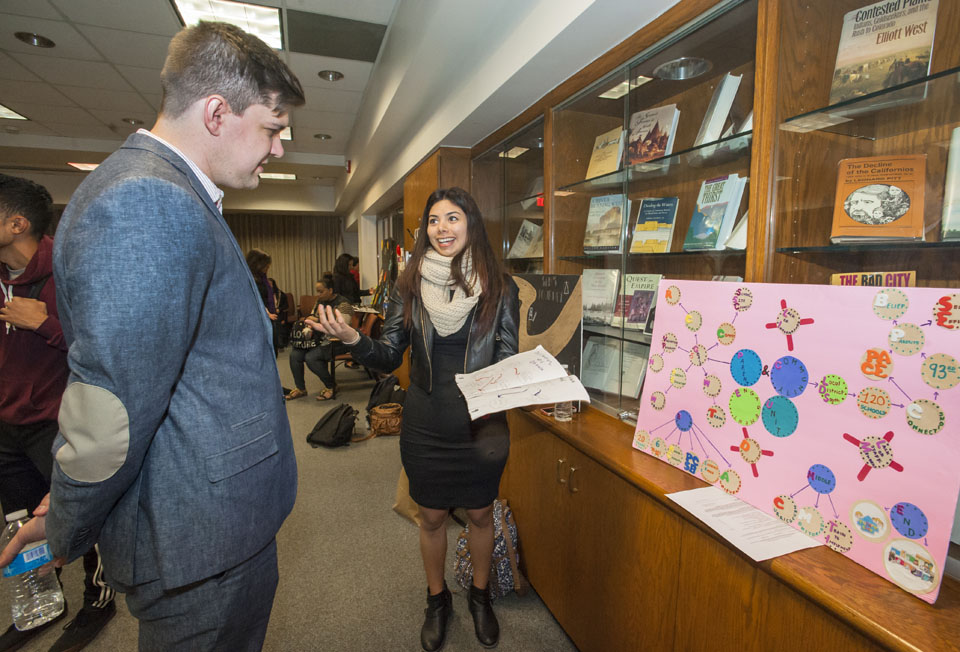CSUN Faculty and Students Use Creative Arts to Identify Barriers to Nonprofit Services
California State University, Northridge sociology professor Moshoula Capous-Desyllas and sociology graduate students Aleksey Reshetnikov, Patricia Lara and Elizabeth Bogumil are researching people’s pathways to nonprofit services in an unconventional way — through the creative arts and visual mapping methodologies.
Funded by CSUN’s Isabelle Walker Endowment for Nonprofit Organizations Studies, the project highlights the pathways that clients take to get services from various nonprofit organizations. The project was inspired by an experience that Bogumil had with a homeless CSUN student who was looking for help.

From left: Sociology professor Moshoula Capous-Desyllas, and sociology graduate students Elizabeth Bogumil, Patricia Lara and Aleksey Reshetnikov. Photo by Luis Garcia.
“As a person or organization wanting to link individuals to services they need and that can make a difference in their life, it is sometimes difficult to know whether you are providing a reference to a service that is pertinent for and appropriate to the situation — or if these services are even made available and accessible to those in need of them,” Bogumil said.
The sociology project was a collaborative endeavor. Undergraduate students interviewed clients at their internship sites and used this information to create art illustrating their clients’ experiences. Students interned with a variety of nonprofit organizations serving a wide range of people: the homeless, domestic violence and sexual assault survivors, public school students, older adults, sex workers, single mothers and children in foster care.
Students produced posters, videos and photos, which the research team will analyze to create one cohesive, complex and multi-layered visual map representing client pathways to services. Each person on the team brings an artistic sensibility to the table — Lara is an illustrator, Reshetnikov does multimedia work, Bogumil is a blogger and Capous-Desyllas is an arts-based researcher.

Sociology student Aleksey Reshetnikov and sociology undergraduate, Denice Castillon. Photo by Luis Garcia.
Reshetnikov said visualizing their research — in addition to writing an academic paper — can produce more benefits to the public, as the chances of the average person learning about their findings would be lower if only a paper was available.
“This is really exciting for the nonprofits to get to visually see where the issues are, so they can address them,” he said. “Our paper only allows us to connect with other academics, while the visualization lets us reach a much broader audience.”
Capous-Desyllas, who has worked in the social services field for more than a decade, said accessing services initially can be challenging. The nonprofits involved in the project could benefit from understanding barriers and seeing how they can better reach out to the public and assist their clients, the professor said.
“Some of us in social work and social services get so used to the same resources and don’t get updated information on what type of funding an organization gets, or if their services have changed or discontinued,” Capous-Desyllas said. “Not everybody is up to date on the changing face of the nonprofit world, and hopefully this project will inform the community about new developments.”
Lara said the project helps the nonprofits, as well as providing a great learning experience and resume-builder for undergraduate students who created the maps.
“The undergraduate students’ involvement in this project allows them the opportunity to further immerse themselves into the nonprofit organization, by not only having a clearer understanding of the agency’s structure, but also being privy to how clients perceive the service,” Lara said. “As budding sociologists, this knowledge is an asset they can utilize in their future professions or academic ventures to better address those who are in need of assistance.”
The undergraduates showed their artistic pieces at their class presentation on Dec. 1. Capous-Desyllas said they provided great material to analyze.
“The students’ projects were creative, impactful and powerful representations of their clients’ lives and journeys to accessing social services,” Capous-Desyllas said. “The visualization of these pathways makes the task of comprehensive analysis significantly easier for our research team.”
Sociology major Brigitte Barajas, one of the students who participated in the project and an intern at the Antelope Valley Partners for Health, created a poster showing the pathway to services for a client trying to get custody of his son, who is currently in the foster care system. She said the number of roadblocks the client faced shows how difficult navigating the Department of Children and Family Services (DCFS) can be without nonprofit help.
“[The client] got help from Parents in Partnership (PIP), an organization that supports parents separated from their children by DCFS,” Barajas said. “PIP basically did everything. If someone from PIP had not come to talk to him, he would not have known what he had to do (such as taking parenting classes or DNA testing).”
For her artistic project, Barajas built a miniature version of a house the Antelope Valley mayor provides for parents to visit with their kids. She serves as a coach for families, guiding them in areas they may need help, to be able to reunite with their children. Using art provided a chance to show what is valuable to a client’s pathway to services, Barajas said.
“It’s so nice for families to have a place to meet other than McDonald’s, to start transitioning back into a home environment,” Barajas said. “There are pictures of the living room and kitchen of the actual home inside the little replica. Using art in this way can help nonprofits to see what is important to the families and clients they serve.


 experience
experience